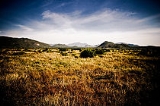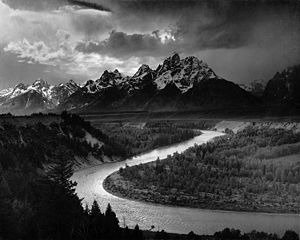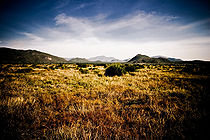
Landscape photography
Encyclopedia

Objectives

Landscape
Landscape comprises the visible features of an area of land, including the physical elements of landforms such as mountains, hills, water bodies such as rivers, lakes, ponds and the sea, living elements of land cover including indigenous vegetation, human elements including different forms of...
in photography, as such it has become a very broad term, encompassing urban, industrial, macro
Macro photography
Macrophotography is close-up photography, usually of very small subjects. Classically a macrophotograph is one in which the size of the subject on the negative is greater than life size. However in modern use it refers to a finished photograph of a subject at greater than life size...
and nature photography
Nature photography
Nature photography refers to a wide range of photography taken outdoors and devoted to displaying natural elements such as landscapes, wildlife, plants, and close-ups of natural scenes and textures...
. A beach full of parasols and sunbathers can be a landscape photo, but so can the view through an electron microscope
Electron microscope
An electron microscope is a type of microscope that uses a beam of electrons to illuminate the specimen and produce a magnified image. Electron microscopes have a greater resolving power than a light-powered optical microscope, because electrons have wavelengths about 100,000 times shorter than...
, which shows a different type of landscape. Waterfall
Waterfall
A waterfall is a place where flowing water rapidly drops in elevation as it flows over a steep region or a cliff.-Formation:Waterfalls are commonly formed when a river is young. At these times the channel is often narrow and deep. When the river courses over resistant bedrock, erosion happens...
s, coastlines, seascapes and mountains are especially popular in classic landscape photography. Though many photographs are inspired by traditional landscape painting, the term in photography broader; most places and things can be photographed as a landscape, a kitchen, a lamp, a wall, or even the human body can be turned into a rolling vista by a skilled photographer.
A crucial element of landscape photography is the light to the scenery. Preferred times are dusk or dawn with low angle light which renders the landscape with low contrast and sidelight. This light adds a feeling of depth to the picture and the low contrast usually is beneficial for the picture as there are no harsh contrasts and the very details can be captured. Notable landscape photographers include Ansel Adams
Ansel Adams
Ansel Easton Adams was an American photographer and environmentalist, best known for his black-and-white photographs of the American West, especially in Yosemite National Park....
, Galen Rowell
Galen Rowell
Galen Avery Rowell was a noted wilderness photographer and climber. Born in Oakland, California, he became a full-time photographer in 1972.-Early life and education:...
and Edward Weston
Edward Weston
Edward Henry Weston was a 20th century American photographer. He has been called "one of the most innovative and influential American photographers…" and "one of the masters of 20th century photography." Over the course of his forty-year career Weston photographed an increasingly expansive set of...
.
Environmentalism and landscape photography
From its beginnings and continuing into the present era, some of the most important and celebrated landscape photographers have been motivated not only by artistic aims but also by a love of the natural environment, as well as a desire to see it preserved. For example, Ansel Adams, acknowledged as a pioneer in landscape photography and one of its greatest practitioners, wrote that "It is horrifying that we have to fight our own government to save the environment.". More recently, Galen Rowell, in an interview with BBCBBC
The British Broadcasting Corporation is a British public service broadcaster. Its headquarters is at Broadcasting House in the City of Westminster, London. It is the largest broadcaster in the world, with about 23,000 staff...
journalist Simon Willis
Simon Willis
Simon Willis is a British journalist, who worked for BBC Look North from 1983 until 1999 as a reporter and presenter before moving to BBC Scotland as a reporter and presenter on Newsnight Scotland until 2009....
, said, "The reason that I keep writing is that all my most powerful messages about the fates of wild places that I care about need to have words as well as images."
Camera
The genre often calls for high resolution DSLR, Medium or Large Format cameras to record the very small details of the scenery. For digital cameras, the preferred file format is RAWRaw
Raw is a term referring to food that has not been cooked.RAW or raw may refer to:-Technology:* Raw audio format, a file type used to represent sound as pulse-code modulation data...
, as RAW allows to record a wider dynamic range and all information is retained. With RAW, the camera does not process the file in a destructive way, all information is kept, resulting in significantly high file sizes. One must also understand that in today's DSLR's, there are subtle, crucial pieces of information to be understood. Since there are several makes of cameras, the digital photographer is best able to apply their craft if they understand such things as the camera sensors on the market ie; APS-C, APS-H and full frame sensors which, are equivalent to a 35mm film frame. In order for a photographer using an APS-C sensor(cropped sensor) to understand the actual focal length in terms of the equivalent of a full frame sensor, a formula of the focal length used x 1.6(APS-C crop factor) which gives the photographer the actual focal length they are using. an example given would be: a Canon 7D(APS-C Sensor) using a Canon EF 17-40mm F4 L series lens USM(Ultra sonic motor) lens and a focal length of 20mm x 1.6 = 32mm focal length if the photographer were using a full frame sensor Camera.
Lenses
Usually wide angle lens (24 mm and 35 mm are especially popular) are used to capture the vast scenery of a landscape. For artistic expression, telephoto lenses are used to compress the scenery and emphasize certain aspects (e.g. rendering the moon very big beyond a mountain ridge). For high quality, the lenses are very often prime lenses rather than zoom lenses. Some landscape photographers however prefer medium telephoto lenses and prefer to capture a typical part of a particular scene revealing the detail of the landscape rather than use wide angle lenses that show the vastness of the scene but which lack detail and can be non-specific. Most Lens manufacturers sell an assortment of ultra-wide angle lenses in the range of 10mm through 24mm which are the best for landscape photography since they offer such a large field of view.Filters
To reduce contrast or control exposure, a split neutral density or polarizing filterPolarizing filter (Photography)
The polarizing filter used with most modern cameras is a circular polarizer. The first stage of the polarizer is a linear filter which filters out light that is linearly polarized in a specific direction...
are used very often. Neutral density filters are used to extend exposure and allow to include motion blur (e.g. for waterfalls or waves) in the scenery. UV and skylight type filters can also eliminate the lack of sharpness caused by UV radiation and reduces distant haze. Control of contrast was the major motivator to create the Zone System
Zone system
The Zone System is a photographic technique for determining optimal film exposure and development, formulated by Ansel Adams and Fred Archer. Adams described how the Zone System was developed: "I take this opportunity to restate that the Zone System is not an invention of mine; it is a codification...
, often associated with Ansel Adams
Ansel Adams
Ansel Easton Adams was an American photographer and environmentalist, best known for his black-and-white photographs of the American West, especially in Yosemite National Park....
. Today, the Zone System
Zone system
The Zone System is a photographic technique for determining optimal film exposure and development, formulated by Ansel Adams and Fred Archer. Adams described how the Zone System was developed: "I take this opportunity to restate that the Zone System is not an invention of mine; it is a codification...
may become obsolete for digital landscape photographers as HDR
High dynamic range imaging
In image processing, computer graphics, and photography, high dynamic range imaging is a set of techniques that allows a greater dynamic range between the lightest and darkest areas of an image than current standard digital imaging techniques or photographic methods...
allows a very good control of contrast by combining several exposures of the scenery to one single picture.
Other Equipment
A tripod and a cable release is very often used for landscape photography as this allows minimal camera shake and thus very sharp pictures. Tripods are necessary for such photographic work but, remotes are not necessary but can be used if the photographer so desires. most modern DSLR cameras offer a timer and/or mirror lockup for the prevention of camera shake during shooting. Canon's EOS 5D MarkII for example offers a 2 second and 10 second timer which works as a replacement for using a remote. A remote is required for shooting long exposures over a standard 30 second timed exposure. A remote allows for the shutter to remain open as long as the exposure switch is engaged.Post Production
Digital Photography has provided landscape photographers with a very useful post production tool. Conventional photographs give pictures revealing the best average of brightness and colour. HDRHDR
HDR may refer to:* HDR, Inc., an American architectural and engineering firm* Hard disk recorder* Hevy Devy Records, a record label* High Dose Rate, a treatment technique in radiotherapy* High dynamic range imaging, digital imaging...
post production work allows the photographer to darken and brighten particular parts of the overall scene ( skies often appear brighter in photographs than originally seen) or to tweak colours either to give a more accurate rendition of the scene as seen originally by the photographer or to dramatically enhanse it as in boosting yellows for instance to make an autumnal picture look more so. Burning and dodging have always been used in black-and-white photography to make landscapes more artistic but difficult to do in colour before the advent of digital photography.
Camera Settings
A landscape photographers main purpose is to capture the entire scene of the photograph with acceptable focus from foreground to background.The photographer must use a small aperture, in most cases of F22 which, will give the photographer the focus needed for the foreground to background being in acceptable focus.The late Ansel Adams was a member of the F64 club, meaning, he utilized an aperture of F64 which is nearly pinhole in size in most, if not all of his photographic work. The settings for the lens should be preset as well accordingly. an example given, a Canon EOS 5D MarkII, using a EF 17-40mm F4 L USM lens, the photographer would preset his aperture to F22 and focus his lens to 3ft or 1meter if 3ft isn't present.This should give the photographer a perfect shot every time in terms of settingSee also
- Nature photographers
- Aerial photographyAerial photographyAerial photography is the taking of photographs of the ground from an elevated position. The term usually refers to images in which the camera is not supported by a ground-based structure. Cameras may be hand held or mounted, and photographs may be taken by a photographer, triggered remotely or...
- Underwater photographyUnderwater photographyUnderwater photography is the process of taking photographs while under water. It is usually done while scuba diving, but can be done while snorkeling or swimming.-Overview:...

